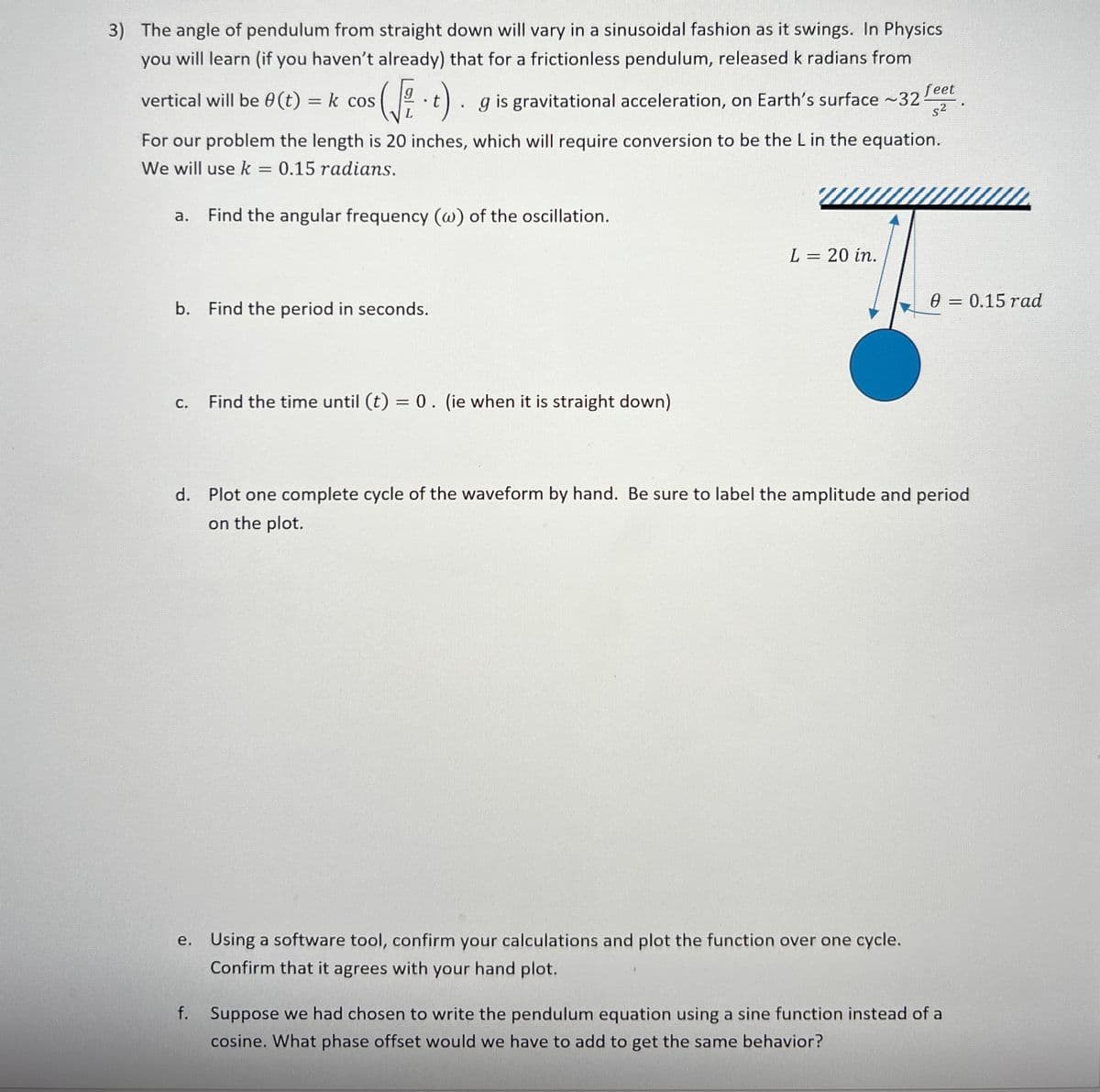The angle of pendulum from straight down will vary in a sinusoidal fashion as it swings. In Physics you will learn (if you haven't already) that for a frictionless pendulum, released k radians from feet vertical will be 0 (t) = k cos (t). g is gravitational acceleration, on Earth's surface~32 s2 %3D For our problem the length is 20 inches, which will require conversion to be the L in the equation. We will use k = 0.15 radians.
The angle of pendulum from straight down will vary in a sinusoidal fashion as it swings. In Physics you will learn (if you haven't already) that for a frictionless pendulum, released k radians from feet vertical will be 0 (t) = k cos (t). g is gravitational acceleration, on Earth's surface~32 s2 %3D For our problem the length is 20 inches, which will require conversion to be the L in the equation. We will use k = 0.15 radians.
College Physics
10th Edition
ISBN:9781285737027
Author:Raymond A. Serway, Chris Vuille
Publisher:Raymond A. Serway, Chris Vuille
Chapter13: Vibrations And Waves
Section: Chapter Questions
Problem 32P: A spring of negligible mass stretches 3.00 cm from its relaxed length when a force of 7.50 N is...
Related questions
Question
2d and 2f answered please

Transcribed Image Text:3) The angle of pendulum from straight down will vary in a sinusoidal fashion as it swings. In Physics
you will learn (if you haven't already) that for a frictionless pendulum, released k radians from
feet
vertical will be 0 (t)
= k cos
(t). gis gravitational acceleration, on Earth's surface ~32
s2.
For our problem the length is 20 inches, which will require conversion to be the L in the equation.
We will use k = 0.15 radians.
а.
Find the angular frequency (w) of the oscillation.
L = 20 in.
e = 0.15 rad
b. Find the period in seconds.
Find the time until (t) = 0. (ie when it is straight down)
С.
d. Plot one complete cycle of the waveform by hand. Be sure to label the amplitude and period
on the plot.
e. Using a software tool, confirm your calculations and plot the function over one cycle.
Confirm that it agrees with your hand plot.
f.
Suppose we had chosen to write the pendulum equation using a sine function instead of a
cosine. What phase offset would we have to add to get the same behavior?
Expert Solution
This question has been solved!
Explore an expertly crafted, step-by-step solution for a thorough understanding of key concepts.
Step by step
Solved in 3 steps with 1 images

Recommended textbooks for you

College Physics
Physics
ISBN:
9781285737027
Author:
Raymond A. Serway, Chris Vuille
Publisher:
Cengage Learning

Classical Dynamics of Particles and Systems
Physics
ISBN:
9780534408961
Author:
Stephen T. Thornton, Jerry B. Marion
Publisher:
Cengage Learning

University Physics Volume 1
Physics
ISBN:
9781938168277
Author:
William Moebs, Samuel J. Ling, Jeff Sanny
Publisher:
OpenStax - Rice University

College Physics
Physics
ISBN:
9781285737027
Author:
Raymond A. Serway, Chris Vuille
Publisher:
Cengage Learning

Classical Dynamics of Particles and Systems
Physics
ISBN:
9780534408961
Author:
Stephen T. Thornton, Jerry B. Marion
Publisher:
Cengage Learning

University Physics Volume 1
Physics
ISBN:
9781938168277
Author:
William Moebs, Samuel J. Ling, Jeff Sanny
Publisher:
OpenStax - Rice University

Physics for Scientists and Engineers
Physics
ISBN:
9781337553278
Author:
Raymond A. Serway, John W. Jewett
Publisher:
Cengage Learning

Physics for Scientists and Engineers with Modern …
Physics
ISBN:
9781337553292
Author:
Raymond A. Serway, John W. Jewett
Publisher:
Cengage Learning

Physics for Scientists and Engineers, Technology …
Physics
ISBN:
9781305116399
Author:
Raymond A. Serway, John W. Jewett
Publisher:
Cengage Learning